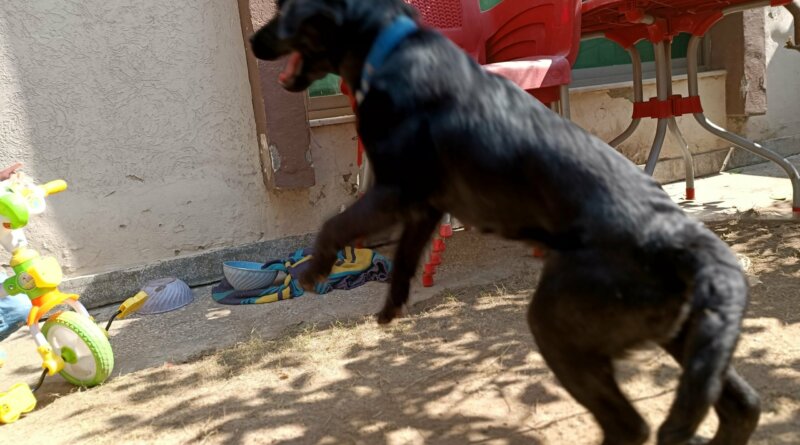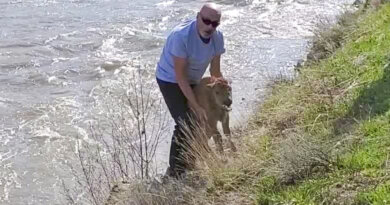5 Best Blind Dog Foundations
Guide dogs are specifically trained dogs that undergo intensive schooling to help people with visual impairment navigate the world.
They assist blind people in ascertaining the positions of objects and people that might come their way.
Chosen for their size, friendliness, and obedience, only 70 percent of the dogs initially chosen make the final cut.
This is to ensure optimum discipline and safety of the dog and the handler.
In short, guide dogs make excellent pets and help you overcome your physical limitations for a more fulfilling life.
Are Guide Dogs Actually Helpful?
Guide dogs lead to smoother and better navigation for blind people.
They assist their owners in locating obstacles in their paths and moving with greater mobility and speed.
Visually impaired people can reach their destination with higher confidence and self-assurance.
Guide dogs also provide social support and companionship.
Upon inquiry, about 50% of people with vision problems in America report having a guide dog.
Guide dogs are considered an effective coping strategy that helps people manage their physical and emotional well-being.
The study also revealed the preference of blind dogs over mobility canes and human chaperones.
People with guide dogs feel more independent than those with other mediums of assistance.
How Does a Guide Dog Help Blind People?
Guide dogs assist the handler in locating any doors or steps that might not be visible to them.
They are responsible for helping avoid unexpected hindrances such as low-hanging branches, traffic, potential curbs, and other pedestrians.
They can help blind people reach their desired destination in a smoother and less time-consuming manner.
Visually impaired people can get to their educational institution, workplace, or any other place with independence.
It is important to remember that while your guide dog may assist you along the route, you must know the overall directions.
These directions include the road you want to take and the vehicle you’ll be using.
The role of the guide dog is limited to making the chosen path as safe as possible from potential obstacles.
On a similar note, they are also incapable of reading traffic signals.
The handler must know the right time to cross the road while the dog helps them in the identification of obstacles.
Can a Completely Blind Person Have a Guide Dog?
Yes, people who are completely blind can benefit from the assistance of a guide dog.
But one must be legally blind to apply for one. This is why you must make sure that all your legal paperwork is in order.
What is the Cost of a Guide Dog?
The cost may vary depending on the school you’re getting the dog from. But it generally falls within $26,000 to $40,000 per dog.
This includes the dog’s breeding, training, and the fee for the course.
What Breed of Dogs Make Good Guides?
Average-sized dogs are regarded as the most appropriate choice for guide dog training.
This is because the dog’s height relative to that of the handler can be a crucial determinant of balance.
You need one that fits your size and needs. Small and large dogs can make the task quite uncomfortable.
Mid-sized breeds are considered the most suitable option. These include:
Apart from size, you may also choose a breed based on allergies, shedding, and temperament. Hypoallergenic dogs are a must for people with allergies.
Make sure to communicate your concerns to the organization you are getting your guide dog from.
This will allow you to choose one that fits your needs physically and emotionally.
Top 5 Foundations That Provide Guide Dogs for Blind People
Guide dogs are an exceptional way to live a safer and easier life for blind or visually impaired people.
If you’re unsure of where to begin your search for one that fits your needs, here is a list of our top 5 non-profit organizations that will help you get your guide dog free of cost:
1. Guide Dogs for the Blind
This largest dog guide school in North America is a wonderful choice for anyone searching for specialized dogs trained by professionals in the United States and Canada.
Built by Lois Merrihew and Don Donaldson in 1942, the firm has empowered people with vision loss to live full lives ever since.
What had emerged as an attempt to help veterans blinded in World War II now consists of more than 2,000 working teams of clients and dog guides.
With their support, there will be no need to squint anymore.
The organization believes in empowering visually impaired people by making guide dogs easily accessible.
You’ll no longer feel afraid of exploring the world.
Your loyal companion will help you navigate your way through life, quite literally!
If you’re still unsure whether this organization is the right choice for you, there are four 90-minute webinars to guide you through the process.
Here you’ll learn about guide dog mobility, the application process, criteria, and a segment customized to the needs of children.
You’ll have to email jkoch@guidedogs.com regarding the program you’re most interested in.
Their team will provide you with a zoom link a few days before the next event.
If you’ve already done the required research and are willing to invest in your future then it’s time to fill out the application form.
You’ll have to fill in your contact information and general data regarding overall health, rehabilitation training, and travel practices.
Click here to be redirected to the application processing.
2. Guide Dog Foundation for the Blind, Inc.
Individuals with blindness, visual impairment, or other disabilities can often suffer due to limited mobility options.
This may result in imposed isolation since a chaperone is needed who might not be readily available.
The Guide Dogs Foundation seeks to resolve this issue through exceptional programs.
These mainly include trained and highly skilled guides and service dogs to make travel easier for them.
Their experienced companion will ease the strain you have to exert on their eyes.
Here is what a client said about the organization’s services:
“The Guide Dog Foundation made a big difference in my life. My life is now not confined to a wheelchair and sitting at home in front of the TV… Now I can take walks on paths in the woods, and although I cannot be involved with my son’s activities as much as I wish, I can at least be there for him”.
You don’t have to stay constricted within your physical limitations when alternatives for a healthier living are available.
Check out this YouTube video about the Guide Dog Foundation for the Blind:
Click here to be redirected to the website for more information.
You’ll be required to sign up for free to access additional tools and information to help you get started.
3. MIRA Foundation USA
MIRA Foundation USA is a non-profit organization that focuses on “enhancing independence for blind children”.
This organization has been training dogs for visually impaired individuals ever since its establishment in 2009.
It provides guide dogs for children between the ages of 11 and 16.
Not only that, but they also provide other resources for legally blind individuals to help them find their way in everyday life.
These include seminars for members with visual difficulties, coping with everyday problems, and the psychology associated with blindness.
The organization has helped numerous children establish a healthier lifestyle through greater access to outdoor activities in a safe environment.
Not only that, the social support that comes with people who are understanding of your condition and potential can be great for the child’s wellbeing.
AJ, one of their competent graduates, explained the negative attitude and behavior one receives from misinformed people and how it can hamper daily living.
AJ’s guide dog enabled him to have a distinct circle of friends that fulfilled his need for belongingness.
Not to mention that he could finally go to university, something his teacher did not believe was possible.
“No more needing to keep people away. There’s no more bumping into things and scaring people by accidentally hitting them.
No more people telling me I wasn’t able to learn things”, he stated regarding his experience.
These days he’s in college and doing well in his classes. He owes all this to MIRA Foundation USA, “who had faith in me and helped me find this great new world I now live in”.
Click here to be redirected to the application form for your guide dog.
Dogs bring joy to everyone’s lives. I know my life is certainly more entertaining with my pet Labrador, Leia.
4. The Seeing Eye
The Seeing Eye is another organization concerned with breeding and training guide dogs to assist blind and visually impaired people.
They are firm believers in the importance of socialization and healthier living regardless of one’s physical limitations.
Driven by a purpose to make living easier, they utilize the firm’s resources to enhance the independence, dignity, and self-confidence of people who are blind, through the use of specially trained Seeing Eye dogs.
It is also worth mentioning that guide dogs undergo socialization in controlled conditions to help them interact appropriately.
For example, guide dogs must not leave the handler when they see another dog or human they like.
The Seeing Eye does a wonderful job of disciplining dogs to ensure the safety of both parties.
The dog and handler learn to collaborate as a team by graduation.
They also provide ongoing assistance, ensuring that their students can contact them later if they encounter a problem.
A part of this process includes recommendations regarding public policy issues to reduce the likelihood of any legal complications.
This guide dog school hosts programs 13 times a year.
These include 24 students driven by their desire to accomplish greater accessibility and safety as they move through life.
The training lasts around 3.5 weeks. Here the students learn to use guide dogs for assistance and taking care of their new lifelong companion.
Click here for online applications and other information regarding the schooling process.
5. Eye Dog Foundation for the Blind
If you’re specifically looking for German Shepherd dogs for assistance with blindness or a visual impairment, the Eye Dog Foundation will provide one free of cost.
They’ve done an excellent job training German Shepherds to help their loving and caring handlers make the best of life.
They not only help with guidance and security but also have unconditional loyalty and affection toward their owners.
This can help minimize the impact of any emotional turbulence the handler may have internalized.
The truth is, people with visual impairment can suffer due to the attitude and behavior of the overall society.
Be it prejudice or misinformation, there can be a slight discrepancy in the hesitance people exhibit toward them while socializing.
While it is not an equal exchange, guide dogs can be an immense source of warmth and joy.
To maximize the benefits derived from their extensive training, completion of an orientation and mobility course is mandatory by the organization’s policies.
A physically, mentally, and emotionally safe home and handler is also a priority. Without the assurance of the given factors, admission is not given.
The firm emphasizes the responsibilities of both parties to ensure great teamwork and collaboration.
Click here to be redirected to their application process.
Blind Dog Foundations: Key Takeaways
Guide dogs can be a wonderful alternative to canes and chaperones.
They not only enhance independence but are also effective mediums of social support and pet therapy for the handler.
While getting a guide dog can be slightly competitive, there are sufficient schools that provide them free of cost.
All that is required is a willingness to learn, and the means to provide for the dog emotionally and financially.
You’ll now be able to make a well-informed decision and start your new life with a loving companion.
If you have any further questions, feel free to ask us in the comments below!
READ NEXT: How to Make Your Dog a Service Dog
The post 5 Best Blind Dog Foundations appeared first on Top Dog Tips.








